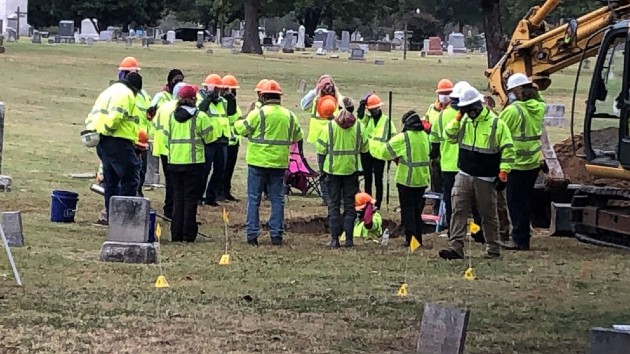Mass grave discovered in search for 1921 Tulsa Race Massacre victims
Tonya Simpson/ABC NewsBy TONYA SIMPSON and JENNY WAGNON COURTS, ABC News
(TULSA, Okla.) — A team of experts searching for victims of Oklahoma’s 1921 Tulsa Race Massacre uncovered what it says is a mass grave on Wednesday, nearly a hundred years after white mobs burned down a section of town known as Black Wall Street.
The group of archaeologists, anthropologists and historians discovered 12 unmarked coffins containing human remains buried at Tulsa’s Oaklawn Cemetery. The discovery comes one day after the group discovered remains in another unmarked coffin nearby.
“This is just an incredible, incredible moment,” Oklahoma State Archaeologist Kary Stackelbeck said Thursday. “We still have many questions to answer but we are definitely a step closer to getting answers.”
The mass grave is located near the headstones of the only two known massacre victims buried in the Black section of the Potters Field at Oaklawn.
This week’s discovery was made in an area known as the “Original 18” site. Funeral home records show that at least 18 massacre victims were buried in the area.
The site is one of several around Tulsa that the group plans to search as part of a city-backed effort to investigate stories of mass graves connected to the massacre.
“While we know that there are at least 18 identified and unidentified-but-known African American massacre victims buried in Oaklawn, we’re looking for any and all riot massacre victims,” said historian Scott Ellsworth.
Work is now underway to determine if the remains found in the mass grave are connected to the massacre. Experts say the remains are fragile, and described the preservation level as “less than ideal.” They say they do not plan to remove the remains from the coffins until they can be fully excavated and analyzed.
The next step is to submit the permits required to exhume the remains.
Forensic anthropologist Dr. Phoebe Stubblefield says requesting permission to remove remains for an investigation with no living victims or suspects is a first for everyone on the research team.
“How to pursue an exhumation when the homicides, the assailants themselves, have long died and there’s no one to charge, is a novel circumstance,” Stubblefield said.
One hundred years ago, Greenwood was an affluent area of Tulsa known as Black Wall Street and was home to 1,200 black residents and hundreds of black-owned businesses. What began as a confrontation between groups of white and Black residents following the arrest of a young Black man named Dick Rowland ended with 35 city blocks being burned to the ground.
Historians believe that as many as 300 people were killed as white mobs destroyed homes, businesses, churches, schools, hospitals and other buildings from May 31 to June 1, 1921. Nearly 100 years later, many of the massacre victims’ bodies have never been found.
Tulsa Mayor G.T. Bynum announced the effort to locate the mass graves in 2018.
“We still have a lot of work to do to identify the nature of that mass grave and to identify who is in it,” Bynum said Wednesday. “What we do know as of today is that there is a mass grave in Oaklawn Cemetery where we have no record of anyone being buried.”
Copyright © 2020, ABC Audio. All rights reserved.

